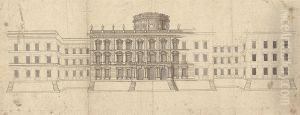Mattia De Rossi Paintings
Mattia de Rossi was an Italian architect and sculptor, born in 1637 in Rome, then part of the Papal States. He was a prominent figure in the Baroque period, a time characterized by dramatic expression and grandeur in the arts. De Rossi was a pupil and close collaborator of Gian Lorenzo Bernini, one of the most influential artists of his time. Under Bernini's guidance, de Rossi developed a profound understanding of Baroque aesthetics, which he later applied in his own works. His contributions to architecture and sculpture during the 17th century played a significant role in the evolution of Roman Baroque style.
De Rossi's career was significantly tied to the Catholic Church, which was the primary patron of the arts during this period. He worked on numerous projects, including the design and construction of churches, chapels, and palaces. One of his notable architectural works is the Church of San Bonaventura al Palatino in Rome, which showcases his mastery in blending architectural elements with the natural landscape. De Rossi also contributed to the completion of the Basilica of Saint Peter, where he followed in the footsteps of his mentor Bernini.
In addition to his architectural achievements, Mattia de Rossi was also involved in sculptural projects and the decoration of interiors, demonstrating his versatility as an artist. His ability to manipulate light, space, and decorative elements made his work stand out, contributing to the opulent and dynamic qualities characteristic of the Baroque period.
De Rossi's influence extended beyond his lifetime, with his works continuing to inspire architects and artists in the following centuries. His contributions to the Baroque movement helped to solidify Rome's status as a center of artistic innovation during the 17th century. Mattia de Rossi died in 1695, leaving behind a legacy that remains significant in the study of Baroque art and architecture. His work not only exemplifies the grandeur and emotion of the Baroque era but also represents a bridge between the Renaissance ideals of harmony and the bold innovations of the Baroque period.
